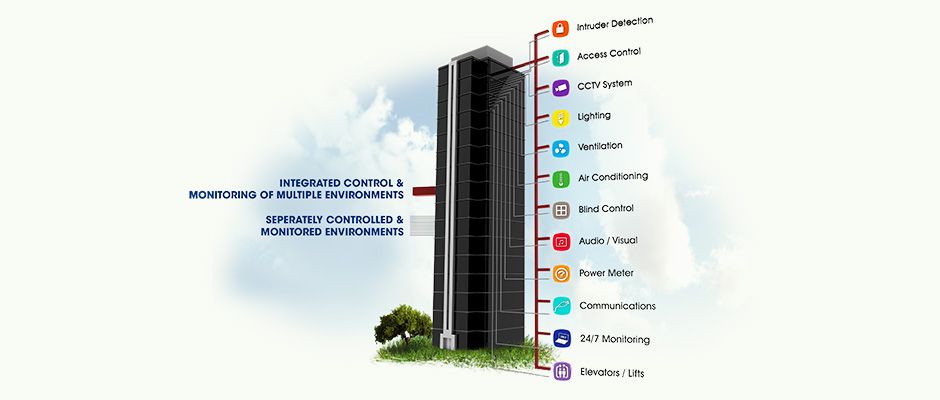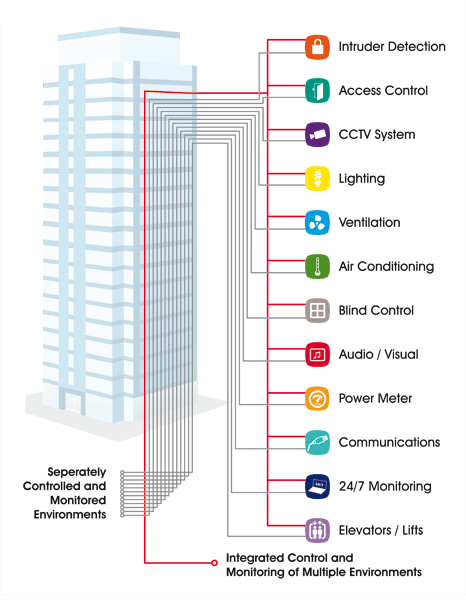If your considering a CCTV system for your business, you’ll probably have questions and concerns that should best be answered by an industry professional.
Tritech Solutions has been providing intelligent building solutions for over 10 years and focuses on three primary areas which include Electronic Security, Building Automation and Energy Monitoring. Being a technology solution provider, we maintain a highly trained and skilled technical team, allowing us to effectively plan projects correctly from the beginning and deliver our solutions based on well thought out and planned solutions.
What we’ve found over the past 10 years of being in business and helping people use technology to create intelligent, secure & simplified environments, was that the default method of making a buying decision for the type of technology we offer is to request a quote. But, without clear documented scope of works and clear beneficial outcomes to the property along with an allocated budget, requesting a quote will not help this process, in fact what we have found is that a quote will often cloud the end results and benefits to that property without a suitable level of education.
Our discovery phase is to spend time with you to understand the benefits or results you are looking for from the new building technology then working with you to provide a suitable level of education on the different options that are available to you in the market. Our business is structured to support customers long term with the selected technology and our aim is to become a valued supplier to ensure the benefit of the product is maintained for as long as possible. We believe that providing a quote initially is an exercise of helping customers to develop a budget which is acceptable for the perceived benefit of some new building technology.
We take pride in developing long standing product partnerships and this has been the corner stone of our success, we have maintained and continue to deliver solutions from global leading products like Pacom Systems, Inner Range, Milestone, Genetec, DVTEL, Axis, Panasonic, Mobotix, Schneider, Savant and RTI. This level of ongoing strong partnership with these product manufacturers provides our customers with the reassurance that our entire team are very competent with these solutions.
So what are the benefits of CCTV anyway?
A CCTV system offers many benefits to an environment, listed below are just some of the most common things we have found can add value to an environment.
- Reduce the likelihood of criminal activity or anti-social behaviour by creating a visual deterrent. (Vandalism or property damage).
- Provide evidence for an investigation or be used to support a case of prosecution.
- Public liability or site safety.
- Ensuring Compliance.
To achieve the above benefits from a CCTV system there are multiple facts to take into account when selecting the correct product, to gain a better understanding of the importance of each benefit will allow a better design consideration to be used for your system.
Ok, so what things should I consider?
Just like selecting a still camera for photography, the camera connected to a CCTV system needs to be correctly selected, configured and set up to achieve a predicable end result. This will ensure the CCTV footage is useful when needed and not a disappointment when trying to conduct an investigation. A CCTV system has NO value if it can’t help you with a problem when it arises. All CCTV systems have the same factors and fixed parameters so understanding the different factors and the effect to each other allows for a well-engineered solution to meet your expectations. We have listed below some factors you should be aware of.
 Image Resolution – Like your TV in your living room or a computer screen, image resolution of a system can vary. Most modern CCTV system are HDTV (720p or 1080p) some are able to support 4K cameras and on the other side of the spectrum some are at resolutions below HD, like older analogue systems. If a system is not configured end to end at a standard resolution your stored images could not meet your expectation. For example HDTV can be 720 or 1080 and also set to record at many different resolutions. Just because a system is a HD system, it doesn’t mean it has been set up to record at this resolution.
Image Resolution – Like your TV in your living room or a computer screen, image resolution of a system can vary. Most modern CCTV system are HDTV (720p or 1080p) some are able to support 4K cameras and on the other side of the spectrum some are at resolutions below HD, like older analogue systems. If a system is not configured end to end at a standard resolution your stored images could not meet your expectation. For example HDTV can be 720 or 1080 and also set to record at many different resolutions. Just because a system is a HD system, it doesn’t mean it has been set up to record at this resolution.
Frame rate and Compression – While a CCTV system is providing you with video, this video is made up of multiple still images. The resolution and timed intervals which the system takes and stores these still images can be different between live and recorded. A system configured correctly to achieve the correct resolution is critical and often misunderstood. We see a lot of system configured with low resolution and frame which can lead to the video footage being useless when needed.
 Retention Time – The time which a system can store the recorded images of each camera at the correct resolution and quality is the retention. Our systems are based on Australian Standards which recommend 31 days of retention. We ensure the storage is calculated to support the retention time at the correct resolution. If the system is not configured correctly the relationship between resolution, quality and time can be adjusted to meet one of the factors at the sacrifices of others. i.e. if you have an expectation that all cameras will be viewed and recorded at HD quality (1080p) all the time, this will require a large amount of hard drive space and can become costly. If you introduce motion recording or event trigged recording you can still maintain live viewing while only recording the image based on an event (motion or trigger) to reduce your HDD storage requirements.
Retention Time – The time which a system can store the recorded images of each camera at the correct resolution and quality is the retention. Our systems are based on Australian Standards which recommend 31 days of retention. We ensure the storage is calculated to support the retention time at the correct resolution. If the system is not configured correctly the relationship between resolution, quality and time can be adjusted to meet one of the factors at the sacrifices of others. i.e. if you have an expectation that all cameras will be viewed and recorded at HD quality (1080p) all the time, this will require a large amount of hard drive space and can become costly. If you introduce motion recording or event trigged recording you can still maintain live viewing while only recording the image based on an event (motion or trigger) to reduce your HDD storage requirements.
 Viewing Angle and Area of Focus – CCTV camera, like an SLR camera can have fixed or vari-focal this provides a different angle of view – wide and narrow. Depending on purpose of a camera in a location, the placement and height of the camera will determine which camera will be used to ensure the viewing angle and focal area is correctly adjusted and set up. There is not a “one camera will fit all” if you are looking for detail from your CCTV system once installed.
Viewing Angle and Area of Focus – CCTV camera, like an SLR camera can have fixed or vari-focal this provides a different angle of view – wide and narrow. Depending on purpose of a camera in a location, the placement and height of the camera will determine which camera will be used to ensure the viewing angle and focal area is correctly adjusted and set up. There is not a “one camera will fit all” if you are looking for detail from your CCTV system once installed.
 Lighting condition and installation environment – The environment which a camera is to be installed needs to be considered, internal, external, IP rating, low light, bright light, changing light (eg car head lights). A camera’s performance will vary based on the environments condition so selecting the right camera for the intended environment is important. This is why the cost of cameras vary so much. If you are looking for a general area view using one camera then that might suit your environment but if you have more specific purpose for the camera then the type of camera to best suit this location should be correctly investigated.
Lighting condition and installation environment – The environment which a camera is to be installed needs to be considered, internal, external, IP rating, low light, bright light, changing light (eg car head lights). A camera’s performance will vary based on the environments condition so selecting the right camera for the intended environment is important. This is why the cost of cameras vary so much. If you are looking for a general area view using one camera then that might suit your environment but if you have more specific purpose for the camera then the type of camera to best suit this location should be correctly investigated.
What are the different technologies?
CCTV systems have evolved on the back of other image based products. Modern CCTV systems take advantage of camera technology which can produce high image quality, low bandwidth but often increase storage space requirements. The most suitable technology for your environment is a combination of a few factors that will provide the maximum return on your financial investment.
Digital Video Recorder (DVR) – Also referred to as an analogue system. These systems are essential, they provide VCR quality that allows you to record the footage onto a Hard Disc Drive (HDD). The image quality and resolution is what you would expect from an old TV or SD (Standard Definition TV). These systems are simple to install, very cost effective, but we are not seeing many if any of them being installed as new systems any longer.
HD over Coax – A migration technology for sites which have existing DVR based systems and coaxial cabling infrastructure looking to improve the image quality without going to the cost of a full system upgrade and cabling replacement. These systems are cost effective as they generally re-use the coaxial cabling which reduces installation labour of a full HDTV system, the cameras produce a HDTV image but are propriety and need to be paired with a main unit to allow the HD signal to transmit over the existing coaxial cabling. The main units are an all in one recording and viewing device which allows the cameras to be directly connected providing scalability in multiples of 16 like DVR’s which they replace.
HDTV (720/1080) and UHD (4K) – These system are very flexible to support multiple camera types, expandable in camera numbers, storage retention time, viewing options, supported resolution, integration with third party products for add on products like Number Plate Recognition, Analytics, Access System integration for better reporting. These type of systems need to be correctly designed to meet IP networking standards and often become costly due to cabling distance which is limited to 90m from a network switch or node location. New installation use UTP cabling opposed to coaxial cabling so upgrade paths can be costly on existing sites which are looking to migrate to a full IP system.
There are always ‘other’ products in our tool kit to help customers achieve their goal in the most cost effective way, like Ethernet over Coax converts, wireless links, HD over coax encoders and a range of other products that allow us to extend the parameters of the systems summarised above. It comes back to the right mix of the correct products to meet a buildings requirement and outcome against an acceptable budget.
Just a special note about Lifts, we are often asked to install cameras in lifts, this can become a very costly exercise depending on the existing cabling infrastructure installed in the lift and the separate costs imposed by your incumbent lift company. Being flexible with the approach to achieve this outcome using the correct head end equipment may allow solutions like wireless cameras to be installed in a lift with edge storage.
The solution could overcome the costing installation requirements of the lift company and provide a level of redundancy to manage the potential drop outs associated with a wireless link and a camera installed in an electrically noisy environment. The approach to the outcome can often allow us to create an acceptable solution for the building but without a level of education it would be difficult to fully evaluate a total solution. Which is why different components are recommended to achieve a complete solution to meet all requirements.
Our approach is to create a solution that meets a buildings requirement, as well as to understand a palatable budget for this type of technology and the time frame for its deployment. With this confidence and developed trust, we both understand that we are entering a long term relationship for the life of the technology.


